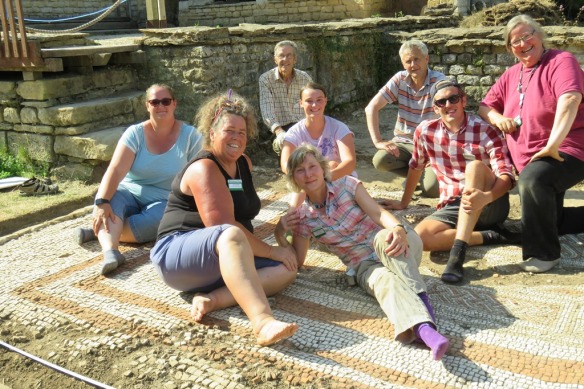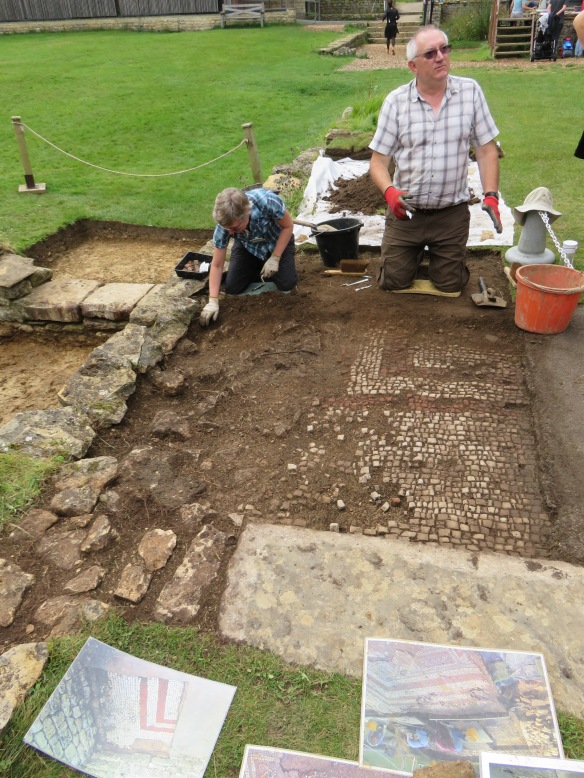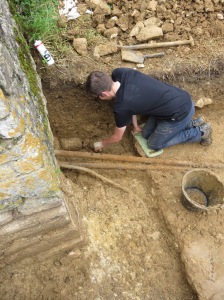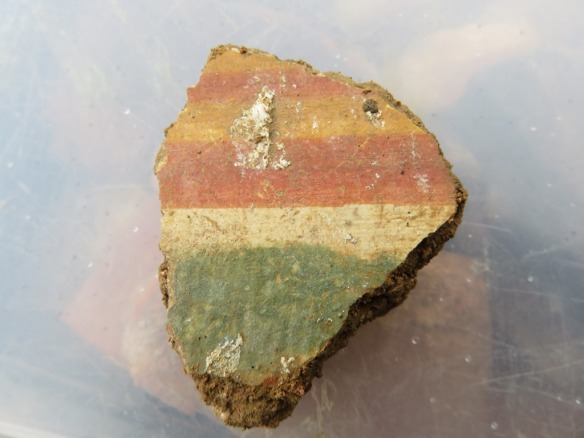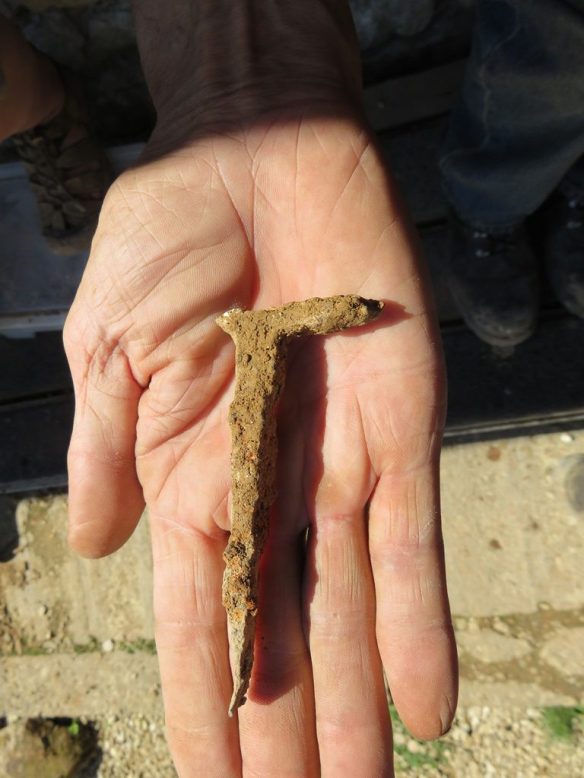The soil is back in place and the dust has settled. The North Range corridor and grand reception room mosaics now lie 10-15cm deep.

Who knows when they will be uncovered again but thanks to the help of so many ..we have been able to make an excellent record ….into the future they can be seen as fine images and videos ….while the originals lie protected from the weather and erosion under the ground.
We had glimpsed bits of these mosaics in 2013, 2014 & 2016. Before that, in 2000, Cotswold Archaeology had uncovered an area and Roger Goodburn revealed other sections in 1990.
We thought that everything had been uncovered by James Farrer in the 1860s.. but this year, we revealed sections of mosaic, particularly along the south side of the reception hall, which were still covered by late Roman building debris..mainly roof tiles and rubble. Simon identified a coin we found here as belonging to Theodosius I (AD 379-395), one of the last Roman emperors to circulate coins in Britain.
This rubble was not a pristine collapse of debris, left where it had fallen after the villa roof fell in. It was a remnant..picked over for goodies perhaps in the 6th-10th centuries. However, we have identified nothing later than the Theodosian coin in this stuff so far.
By the close of the excavation, we had uncovered sections of mosaic covering an area over 30m long and 6m wide. At times, it seemed, we had taken on something over-large ..but the weather, although very hot, helped us work together to achieve the hoped for result. More survived under the tarmac and grass than we suspected.
As we reburied them… we wondered what world the mosaics would be exposed to when eventually uncovered again.
Last year, we excavated the mosaic in Room 28. It was perhaps used as a summer dining room…so lets imagine and go for a stroll with the owner… after a meal taken here in the late 4th century.
We walk from the room and enter the 3m wide corridor with its hopscotch pattern of decorated squares, each a different design. We progress west as far as a chequerboard mosaic doormat in front of a broad stone threshold.
Perhaps servants are here to open the double doors for us and we step into the great reception room. It stretches before us now.. long and broad and high.. decorated with brightly coloured panels of painted wall plaster. The floor is beautiful .. we know it now. Intricate grouped geometric designs bordered by 3 bands of alternating white and red tesserae with a broader white band around the edge of the room.
Half-way along, on the south, is a stepped? external entrance into the courtyard. Although the archaeology was badly damaged here, lines of dressed stones suggest a doorway …and it would be expected.
We still stand in the corridor doorway and directly in front of us at the other end of the room are the kerbstones which mark the entrance to the colonnade leading to the West Range of the villa and the flight of steps which lead to the baths.
Jutting into the courtyard at the south-west corner of the reception hall is the ornate square water feature which we excavated in 2014. Another revelation of the grandeur of this place.
To the right of this, the red stripe border turns west at right angles to mark the position of a foundation (utilising an earlier wall line), a secure foundation for a heavy imposing decorative feature, built against the centre of the room’s west wall. We can imagine an important fixed feature. Perhaps the statue of a god, an ancestor or emperor. From here, leading north, a flight of steps carries us into…the owner’s office. A place of discussion, business and command. This is Room 24, where, in 2014, we found the evidence of the raised pillar hypocaust.
This year, the fragment of carved stone, Nancy found, is thought to come from an ornate stone side table which is evidence for the furniture which once graced this room. We can place this with our exotic eastern mediterranean marble fragment found near the centre of this room in 2014.
Towards the east end of this north wall would have been another door. This time into Room 25 but an entrance less imposing. It did not need steps to enter because Room 25 has a channeled hypocaust .. so the floor was built at the same level as the reception room. The evidence for this doorway is a concentration of erosion, the mosaic floor worn away by 5th to 6th century footfall.. repaired with only mortar and clay at a time when the Romano-British economy had fallen apart and the mosaicists had ceased to trade.
The steps and statue focus on Room 24 ….as the centre of power.
Steve has identified an unexpected change in the central mosaic pattern design and perhaps this pointed to the position of the doorway into the courtyard….but it may just be a mistake.
Of course.. I am spinning a yarn. It is good to have a story and I am giving you my best truth based on an interpretation of the evidence.

A dodgy drawing of my imagined view from the north range corridor through the reception hall towards the colonnade and the west range. The line of kerb stone here suggest a broad open entrance and perhaps, at this point there were once folding shutters rather than doors.. to act as a screen in the colder weather. A splash of blue on the left indicates the water feature. I have picked up the mistake in the central panels of the mosaic and drawn a central doorway to the courtyard on the left. Steps have been created up to room 24 and no steps for the suspected doorway to Room 25. I have put a statue on a plinth to explain the kink in the red stripe border and decided that the staircase to the baths was a single flight accessed from the colonnade. Also two side tables are shown as interpreted by Anthony from the carved fragment Nancy found this year.
There were four other trenches.
Two were to pick up the line of the outer west boundary wall of the villa. We found this wall, made of chunky blocks of stone bonded to the south Nymphaeum wall. Even in the drought the Nymphaeum spring water still trickled into its pool. The wall’s junction with the Nymphaeum shows that it has been largely recreated in the 1860s. There is a straight joint and then the ashlar gives way to irregular blocks of stone. Different phases of construction but not enough time to fully understand the sequence properly.

Where the villa west boundary wall joins the Nymphaeum (scale 20cm divisions)
Peter and I projected the wall line 12m to the south and excavated another trench. Although there was a spread of rubble here, nothing but a patch of mortar indicated that the wall survived this far south.

The second trench to locate the boundary wall. Just rubble this far south. Peter stands where the alignment of this wall joins the Nymphaeum
The third trench was in raised baths Room 21 on the west side of the reception room. This was dug to find the wall dividing the early tepidarium bath with the room we found under the east side of Room 21 in 2015-2016. Amy and Fay found a line of blocks of stone on the proposed alignment but they were loose and we did not have the time in the end to go deep enough to prove the theory.
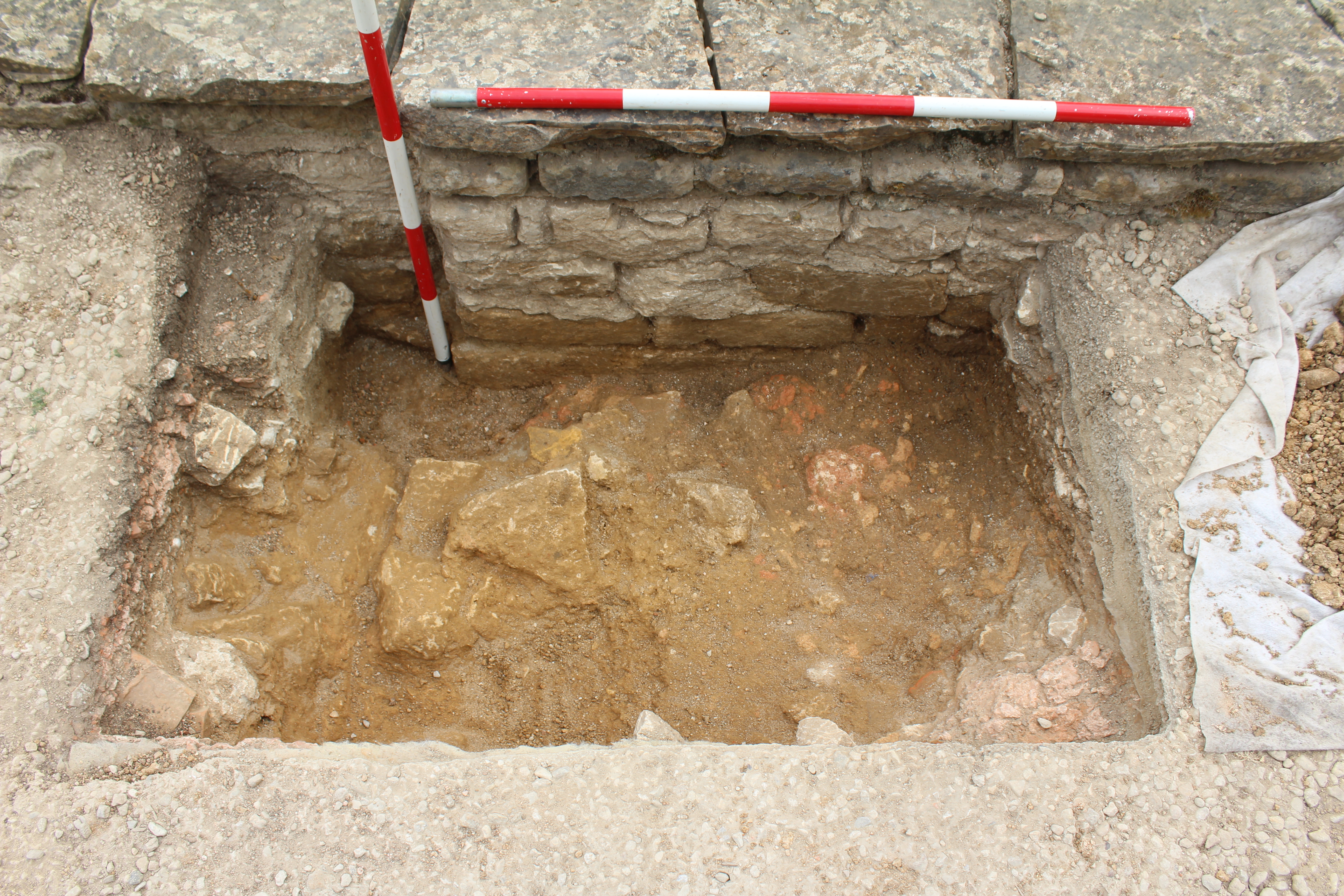
The trench to locate the earlier tepidarium east wall. Richmond interpreted it in his 1960s rebuild where the vertical ranging rod stands. His work cut away the south (top in photo) edge of the archaeology. Displaced blocks of stone on this alignment suggest that it might survive at a deeper level.
The last trench was a revisit and expansion of one excavated in 2016. This was to date three walls. Firstly, the south wall face of the North Range Corridor and Reception Hall. Secondly, the buttress which supports this wall on the south side where the wide doorway leads from the corridor into the reception hall. Thirdly, the east wall of the gallery which divides the inner and outer courtyards of the villa.
I am particularly interested in finding new evidence for the beginning and end of the villa and this trench it seems contains evidence of an earlier phase.
At the end of the 2016 season we found a square flagstone and the top of a heap of yellow mortar and rubble which contained 2nd century evidence. This year we confirmed that the coins in the darker soil, above the yellow building rubble dated to the late 3rd century. Nothing 4th century: which is unexpected because we were sure that both the buttress and the corridor wall had been built towards the end of the 4th century.
I found a cutting against the corridor wall filled with a dark grey silt which had been dug through the deep mortary building rubble. This contained two worn undateable coins. At first it seemed that this was a foundation trench for the corridor wall but it didn’t work archaeologically… The trench cut the rubble.. the rubble was heaped up against the buttress foundation …and the buttress foundation abutted the corridor wall. You see what I mean ? …It creates a time warp. You can’t build a wall before its buttress.
My present story is that it is a later trench cut perhaps to take away a flagstone, a neighbour to the one we found wedged between the buttress and the corridor wall. There may once have been a line of flagstones against the corridor wall here.
The yellow rubble layer was deep and interesting. Full of blue and red painted plaster debris and occasional sherds of pottery including a fragment of samian and the rims of two 2nd century black burnished ware jars. It had been heaped over a water tank beneath a stone spout. If this rubble is late 2nd century then the buttress and corridor wall must be earlier…
…Though of course finds in dumps of rubble can be displaced and redeposited. Cross reference everything and assume nothing.
The tank had an outlet hole that drained into a ditch. The tank and debris sat on a spread of grey limestone slates spread across to create a rough floor surface. On the last day, Stephanie and her daughter found an oyster shell, charcoal and occasional scraps of pottery and tesserae here and Carol and Nick found a deposit of animal bones under the buttress foundation.

The rough stone floor surface continuing under the stone tank and beneath this the foundation of the East Gallery wall. The foundation for the later stone buttress for the corridor is on the right edge of the photograph.
I made one last small incision against the gallery wall and found beneath the stone slab floor and the mortar layer below it, a foundation trench filling and the base of the gallery wall.
So the sequence is clear…first the gallery, then the corridor then the buttress. We will take our samples for radiocarbon dates and Nancy will send the finds for analysis. They will help us tell a better story.. something a little closer to the truth
And so we say goodbye to our excavations at Chedworth Roman Villa. Thank you so much to all the staff, specialist experts and volunteers who have helped us since 2010. Particularly of course the property staff and volunteers at Chedworth. You are all wonderful.
And looking back…Guy, Aparna, Catherine and James…Harry, Kate, David and Mike. Fay and Carol our fine supervisors of course. The core team Peter and Amy, younger Nick and Nick the wise and Stephanie… who discovered archaeology this year and Rob our longest volunteer (since 1986!) who in this last evening photo…conveniently stands where the statue might once have been.

Thank you !













